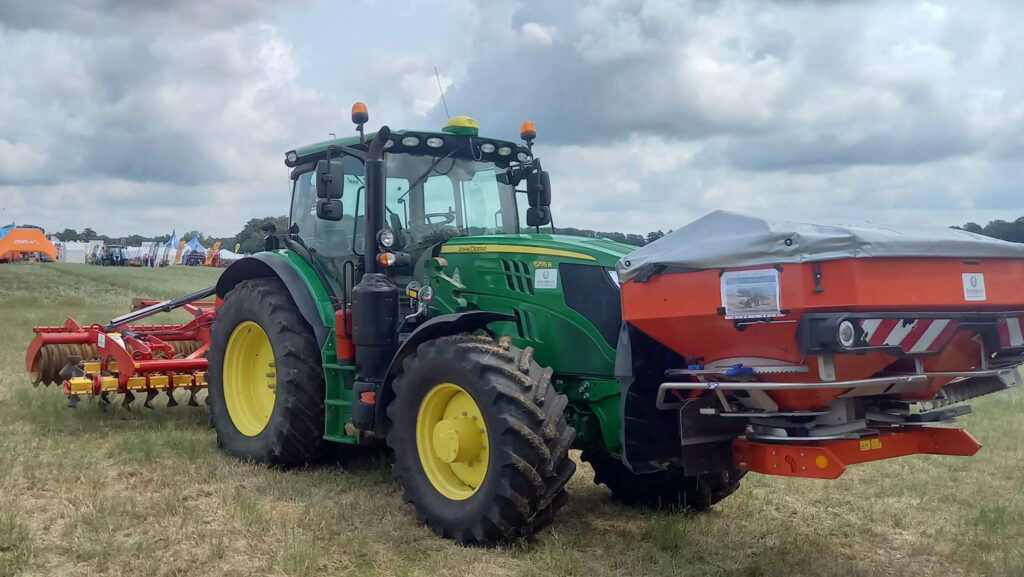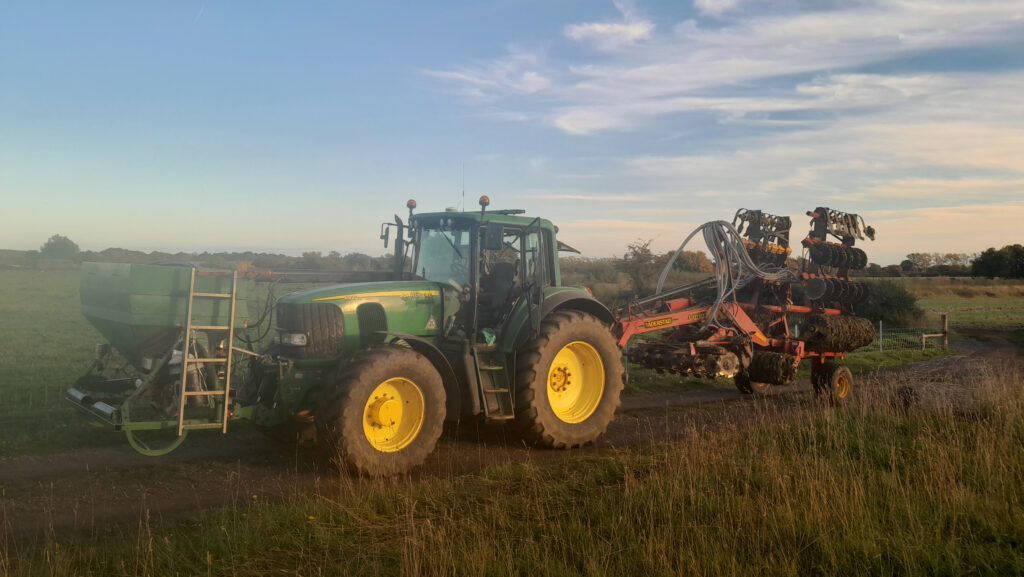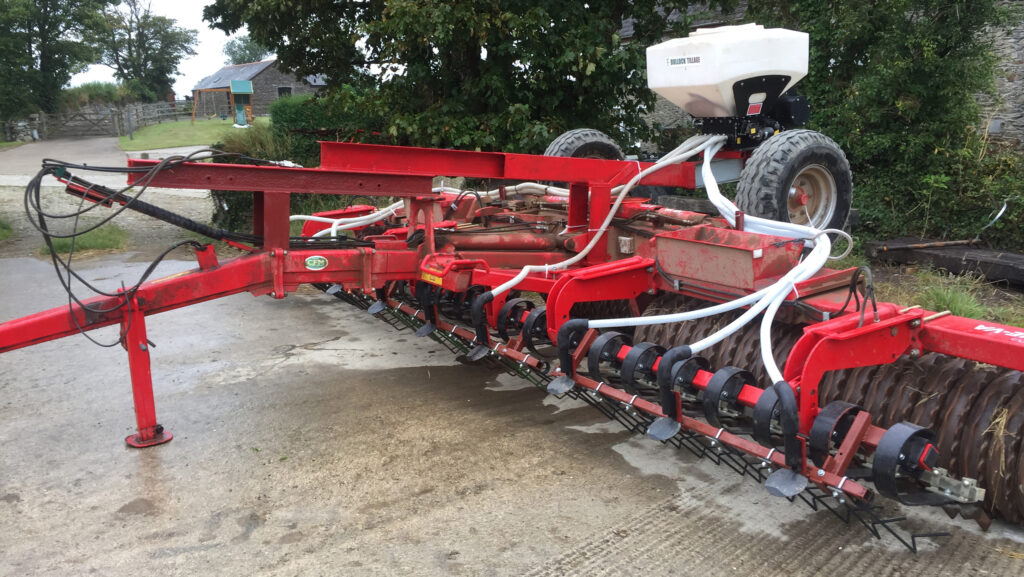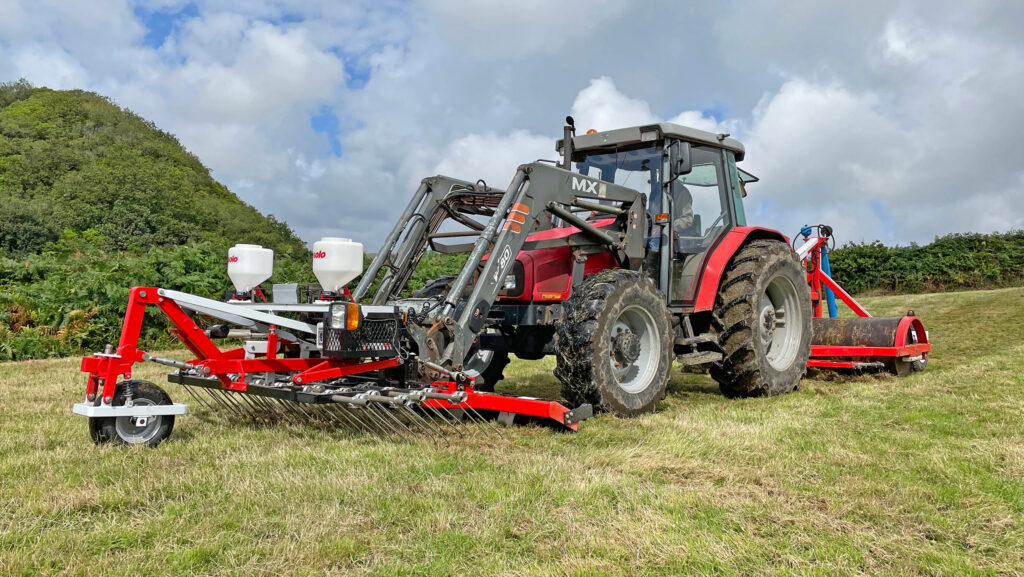Farmers share kit ideas for sowing SFI seed mixes cheaply
Getting the right kit for establishing SFI and Countryside Stewardship seed mixes needn’t cost a fortune. James Andrews takes a look at some nifty home-spun setups.
See also: Low-input cropping plan slashes costs and risk for tenant farmer
John Hawkins’ front-mounted fertiliser spreader

© John Hawkins
Teaming a front-mounted fertiliser spreader with a set of 4m Vaderstad Crosscutter discs has allowed Dorset farmer John Hawkins to establish crops quickly and cheaply.
He uses this setup for a broad range of planting including spring cereals, fertility-building leys, canary grass and Countryside Stewardship mixes such as AB9 winter wild bird food.
Central to this setup is a £500 Unimog gearbox. This is rigged up so that it reverses the drive of his John Deere 6155R’s front pto, allowing it to safely run a conventional Kuhn fertiliser spreader.
This leaves the rear linkage free for the 4m wavy Vaderstad Crosscutter discs, which lightly till the ground before the rear roller firms the seeds into the surface.
Working speeds of 15kph are possible, which allows him to cover 6-7ha/hour while using very little fuel.
To improve accuracy, he sets the 24m spreader to apply a half rate, before working across the field in 12m bouts.
This gives a double overlap spread pattern, which significantly improves the distribution of species in the mix, particularly when working with different sizes of seed.
As the Crosscutter discs are only 4m wide, he fills in the unharrowed gaps once the spreader has been switched off.
The setup has given good results when conditions are favourable, but he admits it is a higher risk approach than conventional drills, particularly on heavier land.
Andrew Metson’s Vaderstad Carrier drill

© Andrew Metson
Serial workshop tinkerer Andrew Metson extensively modified his 5m Vaderstad Carrier to carry out different cultivation tasks and sow cover crops.
For the latter role, he’s fitted the shallow cultivator with a distribution head from an old Accord drill and run a series of pipes to the rear gang of discs.
These place the seeds near the surface, before the rear packer presses them in.
Seed storage and metering is provided by an Accord DF1 front hopper that he picked up for £250, connected to the rear via some flexible tube and a length of rigid soil pipe running up the side of the tractor.
He has only used the machine so far for establishing legume-based cover crops, and has had some good results, particularly when it was set on the lighter side.
With this in mind, he is considering raising the height of his seed outlets – made from lengths of 25mm blue water pipe – so they sprinkle seed over the surface, rather than laying it down next to the disc.
Andrew Carbis’ Cambridge roller seeder

© Andrew Carbis
Initially built for reseeding grass, Andrew Carbis’ Cambridge roll-based drill is earmarked to put in some 90ha of herbal leys this season.
The starting point for the project was a 6.3m set of He-Va rolls, which were fitted with a set of levelling paddles for knocking down ploughed ground.
To this, he added a simple cantilever frame that to holds a Delimbe pneumatic seeder unit from Bullock Tillage.
Seed pipes from these feed spreader plates mounted on a bar in front of the levelling paddles, with a row of Accord levelling harrows underneath to scratch up some tilth.
To cut costs, the seeder unit hasn’t been fitted with a speed sensor, so Andrew calibrates it for a set speed of about 6kph.
John Phizacklea’s overseeder

© John Hawkins
Cornish farmer John Phizacklea built a single pass overseeder on a shoestring budget. It mounts to the front loader of his tractor, allowing him to lift the machine over hedges and negotiate tight entrances.
This setup also leaves the rear drawbar free for towing a flat roll.
Fitted with four rows of angled tines, the machine teases out dead grass and creates some tilth, while a pair of Solo broadcasters spin out small seeds, such as clover.
These were originally hand cranked, but by fitting them with electric motors and a variable-speed controller he can run them electrically.
He can also vary disc speed to suit different types of seed, and has set the units up to give a double overwrap spread pattern for improved accuracy.
Small seed hoppers do limit output, so he has considered building a bulk hopper to increase capacity.

